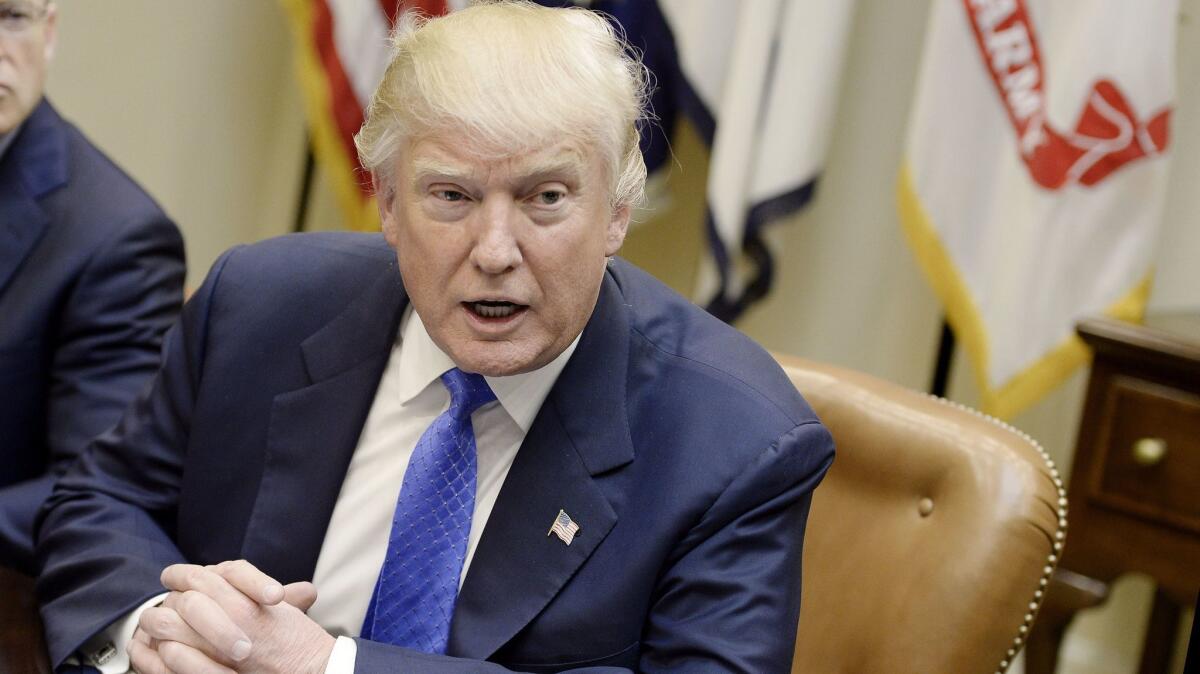One comment from Trump shows his administrationâs message on immigration has been muddled

Reporting from Washington â When President Trump boasts of progress heâs made on his biggest campaign promise â to build a wall and stem the flow of illegal immigration across the southern border â he speaks in terms of unadulterated success.
But few others in the administration go so far. And with White House spokespeople, Cabinet secretaries and immigration officials more willing than the president to acknowledge the far more complicated state of immigration in the U.S., a muddled picture has emerged on where the Trump administration is headed.
Thursday offered a clear example of the problems that arise when Trump and his top aides send different messages.
Discussing recent immigration raids around the country, the president touted an unprecedented âmilitary operationâ targeting criminals that resulted in 680 arrests.
âYou see whatâs happening at the border. All of a sudden for the first time, weâre getting gang members out,â he said. âWeâre getting really bad dudes out of this country, and at a rate that nobodyâs ever seen before.â
But just last week, the Department of Homeland Security cast the operation as routine.
And in Mexico City hours after Trump spoke, Homeland Security Secretary John F. Kelly pushed back on accusations that he had embarked on a mass deportation of people living in the U.S. illegally.
âWeâll approach this operation systematically, in an organized way, in a results-oriented way, in an operation and in a human-dignity way,â he said while on a diplomatic mission with Secretary of State Rex Tillerson.
White House Press Secretary Sean Spicer tried to reconcile one apparent contradiction between Trumpâs and Kellyâs comments, saying the president meant only that the operation was military-like in its efficiency.
âThe president was using that as an adjective,â Spicer said of Trumpâs word choice.
The back-and-forth underscored the communications confusion that has quickly become a signature of the Trump administration. It is an outgrowth of the presidentâs salesman-like tendency toward exaggerated terms, aidesâ repeated false assertions and strategistsâ goal of quickly upending bureaucracy and steering it away from Obama administration policy.
Some immigration experts say the conflicting messages serve their own purpose.
âThe only thing to me that is clear coming from the chaos of the administration is the priority is fear â instilling fear,â said Marshall Fitz, an immigration expert at the Emerson Collective, a nonprofit advocacy organization based in Palo Alto.
It is too early to say whether Trumpâs orders boosted deportations. Figures for February, Trumpâs first full month in office, wonât be available for weeks.
Deportations in January were down slightly from the same month in 2016. Immigration officers removed 16,643 people in January across both administrations, down 22% from the month before, and slightly fewer than 17,649 people deported in January of last year, according to U.S. Immigration and Customs Enforcement.
In an address to conservative activists outside Washington, White House Chief of Staff Reince Priebus and Trumpâs chief strategist, Stephen K. Bannon, both listed the administrationâs early approach to immigration as among the most crucial steps Trump has taken.
âProtecting the sovereignty of the United States, putting a wall on the southern border, making sure that criminals are not part of our process â these are all things that 80% of Americans agree with and these are all things that President Trump is doing,â Priebus said.
In a host of areas, the president and aides are keen to demonstrate a break from Obama-era policy.
Trump campaigned on what he characterized as a threat to national security posed by criminals illegally crossing the border, especially while President Obama was in office, and his remarks Thursday in the White Houseâs State Dining Room echoed that.
âWhat has been allowed to come into our country, when you see gang violence that youâve read about like never before, and all of the things â much of that is people that are here illegally,â Trump said. âTheyâre rough and theyâre tough, but theyâre not tough like our people. So weâre getting them out.â
But with his harsh rhetoric, Trump has mostly ignored that Obama also sought stronger border security and immigration enforcement. Obama was in part trying to create space for a bipartisan legislative effort to enact more comprehensive reform.
Deportations under Obama peaked at 400,000 people in 2012, touching off widespread criticism from immigration advocates, which prompted Homeland Security to scale back deportations.
Last year, deportations fell to 240,000 as the Obama administration focused on targets similar to what Trump described in the raids conducted under his authority: criminals, repeat immigration violators and recent arrivals.
It could take months before deportation levels increase, as immigration officials have limited staff and detention space to hold people. Also, immigration courts are severely backlogged, leading to long delays before a judge officially authorizes someone to be removed.
In the meantime, immigrants in the U.S. illegally can find themselves plumbing any utterance from the administration for signs of whatâs to come.
âIt is attrition through terror or creating so much chaos that people throw up their hands and leave,â Fitz said of the administrationâs strategy so far. âIt is certainly not a plan that has a carefully delineated set of priorities based on certain judgments on who presents a threat and who doesnât.â
Times staff writer Brian Bennett contributed to this report.
Twitter: @mikememoli
ALSO
What you need to know about the Trump administrationâs new immigration rules
Trump administration clears the way for far more deportations
How Trumpâs expanded deportation policy is being felt across the U.S.
More to Read
Get the L.A. Times Politics newsletter
Deeply reported insights into legislation, politics and policy from Sacramento, Washington and beyond. In your inbox three times per week.
You may occasionally receive promotional content from the Los Angeles Times.











